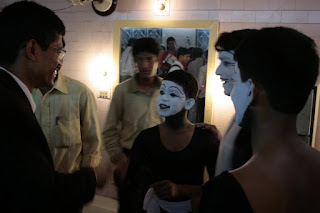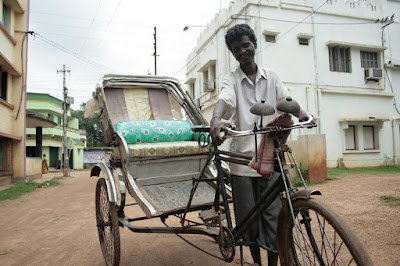After his final show on Friday, Jogesh reappeared on stage, dressed in white shirt and trousers, and laid his wig and costume on the floor. Fittingly, the ‘poet of silence’ didn’t utter a word. But to those who clamoured for the show to go on, he assured that he would continue to teach mime. And thus, mime will live on.

He signed autograph on the leaflet for me.

Still I met him in the green room. Pierre took the picture.

He cried on the stage.
However Pierre was able to see the show.

When
Friday, 21 August, was Jogesh ‘wordless wonder’ Dutta’s last act on stage, bringing to an end a glorious, 53-year career that won him accolades and awards from across the globe. A pioneer in mime, he washed dishes at a tea stall, was a grocer’s assistant and worked at construction sites before finding his true calling. His parents died when he was very young. He grew up in his uncle’s house and ran away since he was tortured there.
“I was always a keen observer of people and their acts. As a teenager, I used to imitate people, and as word spread, I was invited to perform at colleges, office functions and private soirees. Meanwhile, I also did some acting on stage with a theatre group,” Dutta says.
“I didn’t know what mime was about then,” he says.
While his inspiration was Charlie Chaplin, Jogesh keenly observed young couples snatching a few private moments on the banks of a lake in the city and started imitating them, much to the delight of his friends and associates.
In 1956, he created his first real mime act—a lady dressing up in front of a mirror. The same year, he regaled spectators with this, in what was also his first stage mime performance, at Bally near Kolkata. “I started getting noticed and invites for shows from then on. The National Youth Festival in 1960 at
“Invitations from all across the country, and then the world poured in since then,” says Dutta, relaxing in his well-appointed apartment at
Dutta’s repertoire includes well over a hundred acts, most of them short and hilarious recreations of scenes from everyday life with a strong undercurrent of sympathy for the poor and underprivileged, with whom he still closely identifies.
“I can never forget my early childhood and the difficulties we faced. We were very poor,” he says. Some of his most famous acts in the comic category are Haircutting Salon, Walking, Bus Passenger, A Naughty Boy and A Society Lady, while his sympathy for the underdog comes through in Unemployed Youth, The Old Servant and The Exploited Labour.
Jogesh founded his own troupe, Podaboli, in 1971 and started, with the help of the Bengal government, the
Dutta’s final act was his hugely popular The Thief. “I’m old and can’t take the rigours of staging an act anymore. Mime shows require agility and swift physical movement and that’s becoming difficult for me,” he says.
credits: http://www.openthemagazine.com/article/arts/the-life-and-mime-of-jogesh-dutta










.jpg)






.jpg)
.jpg)

.jpg)


.jpg)
.jpg)
.jpg)

